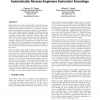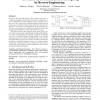14 search results - page 1 / 3 » Derive: a tool that automatically reverse-engineers instruct... |
DYNAMO
2000
13 years 6 months ago
2000
Many binary tools, such as disassemblers, dynamiccode generation systems, and executable code rewriters, need to understand how machine instructions are encoded. Unfortunately, sp...
ESORICS
2009
Springer
14 years 5 months ago
2009
Springer
Automatic protocol reverse engineering has recently received significant attention due to its importance to many security applications. However, previous methods are all limited in...
CCS
2008
ACM
13 years 6 months ago
2008
ACM
Recent work has established the importance of automatic reverse engineering of protocol or file format specifications. However, the formats reverse engineered by previous tools ha...
NDSS
2008
IEEE
13 years 11 months ago
2008
IEEE
Protocol reverse engineering is the process of extracting application-level specifications for network protocols. Such specifications are very helpful in a number of security-re...
PLDI
2006
ACM
13 years 10 months ago
2006
ACM
In order to generate high-quality code for modern processors, a compiler must aggressively schedule instructions, maximizing resource utilization for execution efficiency. For a ...


